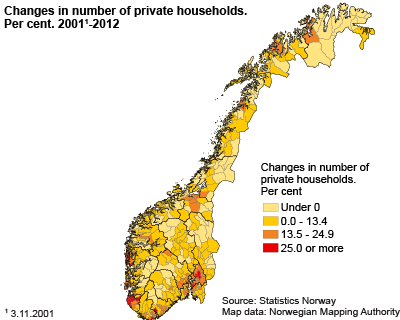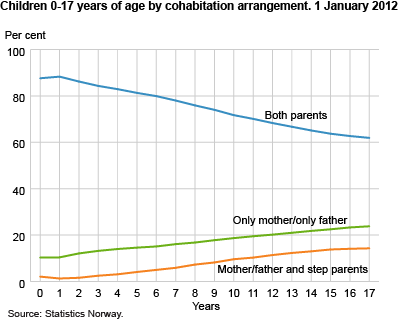Content
Published:
This is an archived release.
265 000 more households in 10 years
The number of households increased by 264 500 to 2 226 000 from 1 January 2002 to 1 January 2012. This corresponds to an increase of 14 per cent. During the same period, the population has increased by 465 000 persons or 10 per cent. Twenty-two municipalities have experienced an increase of more than 25 per cent.
The increase has been especially big in the areas around the international airport Gardermoen as well as the area surrounding the cities Stavanger and Bergen. The municipality of Ullensaker has seen a 43 per cent increase in the number of households. A total of 138 municipalities have experienced a decrease in the number of households. Among the 19 municipalities with a decrease of 10 per cent or more, 17 were situated in the three northernmost counties.
| Growth | Loss | ||||||||||||||||||||||||||||||||||||||||||||||||||||||||||||||||||||||||||||||
|---|---|---|---|---|---|---|---|---|---|---|---|---|---|---|---|---|---|---|---|---|---|---|---|---|---|---|---|---|---|---|---|---|---|---|---|---|---|---|---|---|---|---|---|---|---|---|---|---|---|---|---|---|---|---|---|---|---|---|---|---|---|---|---|---|---|---|---|---|---|---|---|---|---|---|---|---|---|---|---|
| (292 total)(Norway=13.5) | (138 total) (Norway=13,5) | ||||||||||||||||||||||||||||||||||||||||||||||||||||||||||||||||||||||||||||||
| 1 | 0235 Ullensaker | 42.7 | 1917 Ibestad | -12.0 | |||||||||||||||||||||||||||||||||||||||||||||||||||||||||||||||||||||||||||
| 2 | 1142 Rennesøy | 40.3 | 2024 Berlevåg | -12.4 | |||||||||||||||||||||||||||||||||||||||||||||||||||||||||||||||||||||||||||
| 3 | 1121 Time | 34.3 | 1874 Moskenes | -12.5 | |||||||||||||||||||||||||||||||||||||||||||||||||||||||||||||||||||||||||||
| 4 | 0226 Sørum | 33.6 | 1857 Værøy | -12.5 | |||||||||||||||||||||||||||||||||||||||||||||||||||||||||||||||||||||||||||
| 5 | 0234 Gjerdrum | 32.9 | 1632 Roan | -13.1 | |||||||||||||||||||||||||||||||||||||||||||||||||||||||||||||||||||||||||||
| 6 | 1243 Os (Hord.) | 32.8 | 2028 Båtsfjord | -13.3 | |||||||||||||||||||||||||||||||||||||||||||||||||||||||||||||||||||||||||||
| 7 | 1124 Sola | 32.3 | 1836 Rødøy | -13.3 | |||||||||||||||||||||||||||||||||||||||||||||||||||||||||||||||||||||||||||
| 8 | 1256 Meland | 32.1 | 1915 Bjarkøy (up to 2012) | -14.5 | |||||||||||||||||||||||||||||||||||||||||||||||||||||||||||||||||||||||||||
| 9 | 1120 Klepp | 32.0 | 2014 Loppa | -17.1 | |||||||||||||||||||||||||||||||||||||||||||||||||||||||||||||||||||||||||||
| 10 | 1259 øygarden | 31.3 | 1928 Torsken | -17.6 | |||||||||||||||||||||||||||||||||||||||||||||||||||||||||||||||||||||||||||
| 1 | Per 3 November 2001. |
880 000 live alone
As of 1 January 2012, 880 000 households consisted of one person. This is 40 per cent of the 2.2 million private households in Norway. The 626 000 households consisting of two persons are the second largest group with a share of 28 per cent. A total of 155 000 households consist of five or more persons.
Every tenth child lives with half siblings
Twelve per cent of all children below the age of 18 live with half siblings. Almost three in four children live with siblings, whereas two in ten children do not.
The share living with half siblings changes only slightly by age, whereas the share not living with siblings falls from 43 per cent during the first year of age to around 12 per cent at the age of eight. Thereafter, the share rises again, reaching 21 per cent for 17 year-olds. The share living with siblings rises significantly with age, from 49 per cent among the youngest to 80 per cent among those somewhat older. When the children reach their teens, the share drops again somewhat. Not many children live with step siblings, only around one per cent. This share rises with age, from close to zero per cent at birth to slightly above two per cent among 17 year-olds.
There are many reasons for these differences. Among the youngest children, many will be the oldest child because many of them have not yet had siblings. Correspondingly, among the oldest children some will be the youngest because the older ones have moved out. The changes in the cohabitation patterns of the parents as the children grow older are also a contributing factor. The share living with both their parents gradually drop with age, from around 90 per cent during the first year of life to slightly above 60 per cent among 17 year-olds. At the same time, the share living with only their mother or father, or with one of their parents and a step parent, rises as the children grow older.
The statistics are based on registers and legal residence address on 1 January 20121. This means that unmarried students registered at their parents' address are regarded as members of the household of their parents. Experience shows that statistics based on registers and legal residence address result in larger households, fewer one-person households and fewer cohabiting couples than statistics from surveys based on interviews and place of usual residence. The advantage of the kind of register statistics presented here is that they can be broken down into very precise geographical areas. 1 2011 is changed to 2012. |
In connection with the harmonisation of housing and household statistics for the 2011 census, it was decided to re-evaluate the routine for household formation. This resulted in around 13 000 persons who were previously regarded as resident in private households; mostly single persons, being placed in the group “unspecified household status”. For further details, see About the statistics 6.1. |
Tables:
- Table 1 Population by, sex, age and type of household. 1 January 2012
- Table 2 Private households and persons per private household, by county. 1960, 1970, 1980, 1990, 2001, 2011 and 2012
- Table 3 Private households, by type of household. 1980, 1990, 2001, 2011 and 2012. Number and per cent
- Table 4 Private households and persons in private households, by size of household, county, municipality and urban district. 1. January 2012
- Table 5 Private households, by type of household, county, municipality and urban district. 1 January 2012
- Table 6 Private households, by type of household, county, municipality and urban district. 1 January 2012. Per cent
- Table 7 Private households and persons in private households, by type of household. 1 January 2012. Numbers and per cent
- Table 8 Persons in private households, by type of household, county, municipality and urban district. 1 January 2012. Per cent
- Table 9 Families in private households, by type of family, county, municipality and urban district. 1 January 2012
- Table 10 Families in private households with children 0-17 years by, county, type of family and number of children. 1 January 2012
- Table 11 Persons in private households, by sex, cohabitation arrangements and age. 1 January 2012
- Table 12 Couples and persons in couples with and without children in private households, by cohabitation arrangements, number of children in the family and age. 1 January 2012
- Table 13 Couples with and without children in private households, by cohabitation arrangements, county, municipality and urban district. 1 January 2012. Per cent
- Table 14 Persons 18 years and over in private households. Percentage living/not living as couples, by age, county, municipality and urban district.l. 1 January 2012. Per cent
- Table 15 Persons 67 years and over in private house holds, by age, sex and number of persons living in the household. County, municipality and urban district. 1 January 2012
- Table 16 Children 0-17 years, by number of parents in the family, the parents' cohabitation arrangements and the child's age. Per cent. 2001, 2005 - 2012
- Table 17 Children 0-17 years, by number of parents in the family, the parents' cohabitation arrangements, siblings living at home and the child's age. 2001, 2005 - 2012
- Table 18 Children 0-17 years, by number of parents in the family, the parents' cohabitation arrangements and county. 2001, 2005 - 2012. Per cent
- Table 19 Children 0-17 år, by type of siblings living at home and the child's age. Per cent. 2001, 2005 - 2012
- Table 20 Children 0-17 år, by type of siblings living at home and county. Per cent. 2001, 2005 - 2012
- Table 21 Children 0-17 years, by number of siblings and parents living at home and the parents' cohabitation arrangements. Per cent. 2001, 2005 - 2012
- Table 22 Children 0-17 years, by number of siblings and county. Per cent. 2001, 2005 - 2012
- Table 23 Children 0-17 years, by number of siblings and the child's age. Per cent. 2001, 2005 - 2012
Contact
-
Statistics Norway's Information Centre
E-mail: informasjon@ssb.no
tel.: (+47) 21 09 46 42
-
Espen Andersen
E-mail: espen.andersen@ssb.no
tel.: (+47) 92 61 00 46
-
Ane Margrete Tømmerås
E-mail: ane.tommeras@ssb.no
tel.: (+47) 91 99 29 62
-
Oppdrag befolkningsstatistikk
E-mail: befolkning@ssb.no


